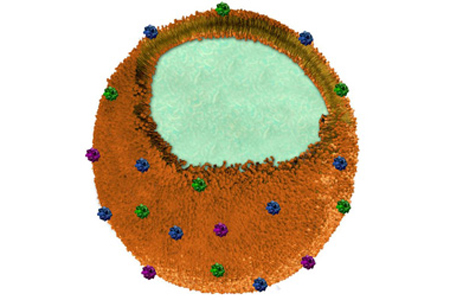'Nanosponges' Sop Up Bloodstream Toxins

(ISNS) – An army of microscopic sponges may someday save your life. Scientists have created tiny, spherical particles -- called nanosponges -- that can soak up harmful toxins found in some venoms and bacteria.
The nanosponges can sop up a particular variety of toxins that injure red blood cells, researchers from the University of California, San Diego reported earlier this month in the journal Nature Nanotechnology.
Nanosponges target toxins that "can essentially organize themselves to poke a hole inside [red blood] cell membranes," said Jack Che-Ming Hu, a post-doctoral researcher at the University of California, San Diego and the lead author on the study. "That leads to cell damage and cell death."
These toxins create punctures, causing red blood cells to pop. Bits of toxin-loaded membrane from the busted-open cell can float off into the bloodstream to assault more cells, making the infected person sick and, in serious conditions, can cause death.
Many bacteria that pose major health concerns, like E. coli, MRSA, and some bacteria that cause pneumonia, release toxins that use this tactic. Also venom from animals including bees, snakes, and sea anemones can riddle a red blood cell with pores.
"The biggest challenge with toxin detoxification is that there are simply so many types of toxins out there," said Hu.
By focusing on toxins that use the pore-forming strategy, a single type of nanosponge is able to capture many kinds of these poisons, instead of being tailored for different varieties. To pull this off, nanosponges masquerade as red blood cells.
Sign up for the Live Science daily newsletter now
Get the world’s most fascinating discoveries delivered straight to your inbox.
Hu's team uses the outer membrane of red blood cells to coat the outside of the nanosponge. This allows the cloaked nanosponges to go undercover, posing as red blood cells.
The toxins attack the nanosponges just as they would a red blood cell. But the center of this particle is made of a ball of lactic acid, an organic material commonly found in the body. It acts like a scaffold and helps prevent the membrane from falling apart, trapping the toxins.
The researchers added nanosponges and two types of pore-forming toxins – one from a strain of bacteria and the other from bee venom – to mice red blood cells in petri dishes. The nanosponges were able to capture over 90 percent of the toxins.
"The toxins -- once they interact with the membrane of these particles -- they are preoccupied or detained," said Hu.
The toxin-soaked nanosponge eventually makes its way to the liver and is removed by the body, said Hu.
One red blood cell can provide enough membrane to coat 3,000 microscopic nanosponges. Scientists would have to line up one hundred of these tiny particles, side-by-side, to reach the width of a typical human hair. Researchers can create an army of nanosponges to far outnumber red blood cells, making it more likely a toxin will bump into the decoy than a true red blood cell.
In another experiment, the team injected live mice with a lethal dose of a fast-acting toxin. If the fleet of nanosponges was deployed two minutes before the toxin, 89 percent of the mice survived. If the nanosponges were given to the mouse two minutes after the toxin, 44 percent survived.
"It's a matter of how fast the toxin acts in your body," said Hu, who expects to see higher levels of survival if a toxin is slower to attack red blood cells.
Hu thinks that nanosponges hold a lot of promise for treating bacterial infections.
The team is hoping to begin work on nanosponges for human use. But long-term risks need to be studied before the absorbent particles make it from laboratory mice to doctor's offices or pharmacies.
The researchers don't yet know if nanosponges will work in people.
"It truly is a foreign body that you're going to be putting in the human body," said Dave Rasko, an assistant professor at Institute for Genome Sciences at the University of Maryland School of Medicine, in Baltimore, who was not involved in the study. "You always have opportunity for there to be some kind of an immune response to that."
Hu and his colleagues have not found any evidence of damaging effects from the nanosponges in mice. He believes that the human immune system will also treat these particles as normal red blood cells.
If the technology is safe, it could become a viable alternative to or used in combination with antibiotics.
"I can see it being a huge thing for people [in] the military or first responders," said Rasko. He thinks nanosponges could also be used against biological weapons like anthrax and ricin.
Ryder Diaz is a science writer based in Santa Cruz, Calif.
Inside Science News Service is supported by the American Institute of Physics.









